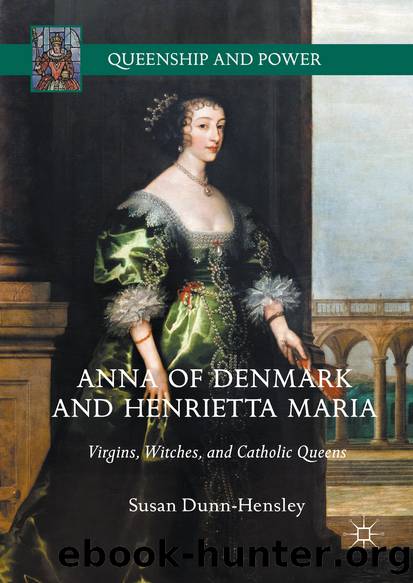Anna of Denmark and Henrietta Maria by Susan Dunn-Hensley

Author:Susan Dunn-Hensley
Language: eng
Format: epub
Publisher: Springer International Publishing, Cham
21
In Lanyerâs verse, Anna becomes the center of a court flourishing in the arts. The forest gods of a Golden Age fall before her, and the moon (often a figure for Elizabeth I) attends upon the Jacobean queen. While this type of praise for a patron is not at all unusual, the gynocentric nature of the dedications suggests a world of women in a lost Golden Age producing art with a fecundity that mirrors that of the female body.
Lanyerâs representation of the queen presiding over a court abounding in artistic achievement is no mere encomiastic exaggeration. Anna actively contributed to the artistic flourishing of the Jacobean court. Not only did Anna contribute to the artistic concepts and vision behind court masques, but she also employed her talented masque designer, Inigo Jones, to design architectural projects for her. These projects included a new residence at Greenwich Palace, which James had given to her in 1613. The palace, which is best known as the Queenâs House, was originally to be called the House of Delight, a name that evokes the celebratory abundance characteristic of Shakespeareâs Egypt. 22 Jones also worked to refurbish Somerset House shortly after her succession (renamed, by royal command, Denmark House) and Oatlands Palace, a refurbishment that also was based on Italian standards (ibid.). 23 Thomas points out that, although the Queenâs House at Greenwich was not completed in Annaâs lifetime and was primarily used by her successor Henrietta Maria, âthe design adhered to Annaâs original concept and was the first truly Classical structure erected in Englandâ (ibid.). Thus, the queen, whose influence on art and culture often goes unnoticed by scholars, in fact inspired not only theatre but also art forms including architecture. 24
Furthering the idea that, in her abundance, Anna fostered an artistic vision for her court, we find that Anna amassed significant artistic collections. Indeed, her considerable jewelry collection was probably âthe largest collection that had been owned by a queen consort to that dateâ (ibid., 73). Her artistic tastes also included paintings; indeed, âthere are more oil paintings of Anne of Denmark than of any previous English queen consortâ (ibid.). Thomas argues that it âwas due mainly to her patronage that the careers of some court painters were launched and those of others founderedâ (ibid.).
In the case of her maternity and her patronage, Annaâs feminine and maternal abundance brought bounty to the state. As a form of excess, however, female sexuality and abundance could be seen to emasculate men, undermine the state, and, in the extreme, evoke powerful forces such as witchcraft. Annaâs excesses, her construction of an oppositional position, and her strong personality challenged male rule. In that way, she resembles Cleopatra who rules her own land and positions herself in opposition to Rome and its patriarchy. These challenges to patriarchy prove significant, for, although aspects of Cleopatraâs court can be read as positive and generative, we cannot escape the fact that Cleopatra participates in Antonyâs downfall. With Cleopatra, Antony plays the role of the sensual pagan god, continually satisfying his physical appetite.
Download
This site does not store any files on its server. We only index and link to content provided by other sites. Please contact the content providers to delete copyright contents if any and email us, we'll remove relevant links or contents immediately.
Spare by Prince Harry The Duke of Sussex(5052)
Machine Learning at Scale with H2O by Gregory Keys | David Whiting(4094)
Never by Ken Follett(3758)
Harry Potter and the Goblet Of Fire by J.K. Rowling(3757)
I Have Something to Say by John Bowe(3458)
Unfinished: A Memoir by Priyanka Chopra Jonas(3313)
Fairy Tale by Stephen King(3192)
Greenlights by Matthew McConaughey(3044)
The Man Who Died Twice by Richard Osman(2977)
Will by Will Smith(2766)
Think Again by Adam Grant(2389)
Rationality by Steven Pinker(2271)
The Dark Hours by Michael Connelly(2211)
It Starts With Us (It Ends with Us #2) by Colleen Hoover(2171)
The Storyteller by Dave Grohl(2146)
Can't Hurt Me: Master Your Mind and Defy the Odds - Clean Edition by David Goggins(2141)
The Dawn of Everything: A New History of Humanity by David Graeber & David Wengrow(2103)
Friends, Lovers, and the Big Terrible Thing by Matthew Perry(2097)
The Becoming by Nora Roberts(2056)
